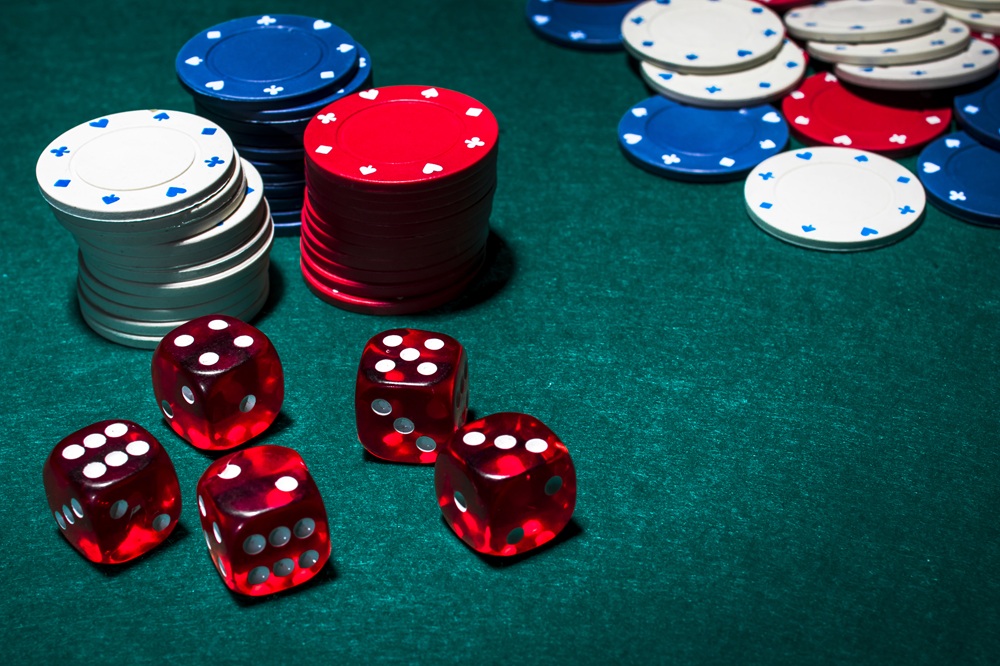This website uses cookies in order to provide you with the best possible user experience. The cookie information is stored in your browser and performs functions such as remembering that you have visited this page before and helping our team which sections represent a greater interest for you. More information on our privacy policy.

At the craps table, the Don't Pass strategy positions a player to bet against the majority of participants. This approach offers a mathematical advantage with a house edge of 1.36%, which is lower than many other craps bets. The Don't Pass bet works as a counterpoint to the Pass Line bet, where instead of betting that the shooter will win, you bet that they will lose.
When placing a Don't Pass bet, you win if the come-out roll is 2 or 3, lose if it's 7 or 11, and push (tie) if it's 12 in most casinos. If any other number (4, 5, 6, 8, 9, or 10) is rolled, that number becomes the point. At this stage, you win if a 7 appears before the point number is rolled again.
This strategy is sometimes called playing the "dark side" because you're essentially betting against other players at the table. While this may create a different social dynamic, the decision to use this strategy should be based on mathematical considerations rather than social pressure.
Experienced players may prefer the Don't Pass bet due to its lower house edge compared to the Pass Line bet (1.41%). The slight improvement in odds can be significant over many betting cycles. Additionally, players can further reduce the house advantage by taking odds bets after a point is established. Many players who enjoy strategic betting also explore other games with favorable odds and features, such as those found inslot malaysia, where a variety of themed slots offer both entertainment and winning potential.
Understanding the Basic Mechanics of Don't Pass Bets
While most craps players bet with the dice, the Don't Pass bet offers a contrarian approach with a modest mathematical edge. This bet positions you against the shooter by wagering that they'll roll a 2, 3, or 12 on the come-out roll, or that they'll seven-out before establishing their point.
On the come-out roll, if 7 or 11 appears, you lose immediately. A 2 or 3 results in a win, while 12 typically results in a push (though casino rules may vary).
When any other number (4, 5, 6, 8, 9, 10) becomes the point, your bet wins if a 7 appears before that point number repeats.
The Don't Pass bet carries a house edge of approximately 1.36%, slightly more favorable than the Pass Line bet's 1.41%. This marginal advantage explains why some methodical players prefer this option, despite it being less popular at most craps tables.
The Mathematical Edge: Comparing Don't Pass vs. Pass Line Odds
The Don't Pass bet in craps provides a small but mathematically significant advantage compared to the Pass Line bet.
The Pass Line carries a house edge of 1.41%, while the Don't Pass bet reduces this edge to 1.36%, representing a modest improvement in the player's expected return over time.
This difference stems from the handling of specific dice combinations.
With the Pass Line bet, rolling 2, 3, or 12 on the come-out roll results in a loss.
In contrast, with the Don't Pass bet, rolling 2 or 3 wins, but rolling 12 results in a push—the player neither wins nor loses their wager.
This distinction in how the number 12 is treated creates the 0.05% difference in house edge.
While this margin may appear minimal, it accumulates in significance during extended play sessions, as the mathematical advantage compounds over numerous wagers.
For players focused primarily on optimal mathematical positioning rather than social dynamics, the Don't Pass bet represents the more advantageous option.
The Social Dynamics of Being the "Table Villain"
Betting on Don't Pass in craps creates a mathematical advantage, but positions the player in opposition to most other participants at the table. This strategy is commonly referred to as taking the "table villain" role among regular craps players.
When employing the Don't Pass strategy, a player wagers against the shooter and most other players who typically place Pass Line bets.
This contrarian position often generates social consequences. Players may experience negative reactions such as disapproving glances or cold treatment when they win while others lose. Some fellow players may verbally express disappointment when a Don't Pass bettor succeeds.
These reactions stem from the communal nature of craps, where most participants traditionally align their interests with the shooter. The Don't Pass bettor disrupts this social cohesion by benefiting from outcomes that disappoint the majority.
To navigate this social dynamic effectively, Don't Pass bettors can maintain standard table etiquette by refraining from conspicuous celebrations and maintaining professional demeanor. This betting strategy remains entirely legitimate within the rules of the game and represents a mathematically sound approach to craps.
Optimal Timing: When to Place Your Don't Pass Bets
Timing your Don't Pass bets strategically can significantly improve your odds at the craps table.
You'll generally find better opportunities after a shooter change, when tables are crowded with recreational players, or when you notice the table falling into cold streaks. Being patient and observant before placing your contrarian bets will help you minimize social tension while maximizing your potential returns.
After Shooter Changes
When a new shooter takes control of the dice, players utilizing the Don't Pass strategy face a decision point. This situation presents a scenario with no established point on the table.
New shooters may experience varying levels of confidence with the dice. While some players might suggest that nervousness affects performance, no empirical evidence conclusively demonstrates that new shooters seven-out more frequently than experienced ones.
The claim that "30% of new shooters seven-out on their come-out roll" lacks statistical validation in controlled studies.
The concept that tired or frustrated shooters make throws that benefit Don't Pass bettors represents a common misconception. Dice outcomes in properly regulated casino environments remain random regardless of the shooter's emotional state or experience level.
For practical purposes, having your bet prepared before the stickman delivers the dice to the new shooter allows for efficient gameplay and prevents delaying the table. This represents good etiquette rather than a strategic advantage.
During Crowded Tables
When placing Don't Pass bets at crowded craps tables, timing is essential for proper table management. The optimal moment occurs after the stickman has pushed the dice to the shooter but before they throw, providing a practical window for bet placement without interrupting game progression.
At busy tables, place your chips directly on the Don't Pass line while clearly communicating your bet to the dealer. Avoid making Don't Pass bets immediately following successful point rolls when other players may be celebrating, as this could create unnecessary tension given the contrarian nature of this bet.
If physical table access is limited due to crowds, simply hand your chips to the nearest dealer with specific instructions for placement. Proper timing and clear communication facilitate smooth gameplay while maintaining appropriate etiquette when implementing this strategy.
Between Cold Streaks
The identification of cold streaks can be a methodical approach for Don't Pass bet placement.
Tables where multiple shooters fail to establish points or where sevens appear frequently after come-out rolls may present statistical opportunities.
Entering between identifiable cold sequences—when the table momentum appears negative but hasn't reversed—allows for strategic positioning.
Reviewing previous roll outcomes on scorecards or electronic displays helps establish pattern recognition.
Consider joining after observing 2-3 consecutive shooters who've demonstrated difficulty establishing or maintaining points.
Avoid immediate betting following a single shooter's failure; adequate observation time helps distinguish between normal statistical variance and potentially advantageous betting conditions for a Don't Pass strategy.
Combining Don't Pass With Don't Come for Advanced Strategy
Combining Don't Pass with Don't Come bets provides an effective method for expanding a dark side craps strategy. This approach creates multiple betting positions that operate independently after the point is established.
When implementing this strategy, a player begins with a Don't Pass bet during the come-out roll. After a point is established, additional Don't Come bets can be placed. Each Don't Come bet operates according to its own sequence, effectively creating parallel Don't Pass bets in progress.
The mathematical advantage of this combination stems from position diversification.
With multiple Don't bets working simultaneously, the player gains several opportunities to benefit from the house edge associated with these bets. If one point number is rolled, resulting in a loss on one bet, the other Don't bets remain active.
This approach helps manage bankroll fluctuations by distributing risk across different numbers.
Since Don't Pass and Don't Come bets carry a house edge of approximately 1.36%, this combination maintains the statistical advantage that makes dark side betting mathematically sound.
Players should note that this strategy increases the total amount wagered, which means proper bankroll management becomes more crucial when implementing multiple simultaneous bets.
The diversification reduces variance but doesn't eliminate the inherent risk associated with any gambling activity.
Navigating the Don't Pass Bar 12 Rule
Most craps players encounter the "Bar 12" rule when placing Don't Pass bets. This rule specifies that if a 12 is rolled on the come-out, the Don't Pass bet results in a push—neither winning nor losing.
The Bar 12 provision exists as a house protection mechanism. Without this rule, the Don't Pass bet would actually hold a mathematical advantage over the casino. By implementing the push on 12, the casino maintains its house edge of approximately 1.36% on Don't Pass bets.
When developing a craps strategy, players should account for these pushes in their expected return calculations and bankroll management. The Don't Pass bet remains one of the better wagers in craps despite this rule, but understanding this mathematical adjustment is essential for accurate assessment of potential outcomes during play.
Bankroll Management for Don't Pass Players
Effective bankroll management is essential for Don't Pass betting in craps.
As a contrary position to most players at the table, this strategy requires both financial discipline and emotional control.
A prudent approach limits single bet exposure to 2-5% of your total bankroll.
With a $500 bankroll, this translates to individual bets between $10-$25.
Establishing predetermined win targets and loss limits helps maintain discipline—such as concluding a session after achieving a 20% increase or sustaining a 30% decrease in your bankroll.
The 3:2:1 ratio represents one structured betting system: allocating three units to the Don't Pass line bet, two units for odds bets (which have no house edge), and one unit for place bets.
This proportional approach helps balance risk across different bet types.
Tracking results systematically allows for assessment of strategy effectiveness and necessary adjustments to betting patterns.
Maintaining separate gambling funds from essential finances prevents problematic gambling behaviors and ensures responsible play.
Common Mistakes to Avoid When Playing the Dark Side
When playing the "dark side" in craps, you'll often face the temptation to increase your bets after losses in a desperate attempt to recover quickly.
You're making a critical mistake if you don't utilize odds bets, which offer the lowest house edge in the entire casino.
Successful Don't Pass players recognize these common pitfalls and maintain discipline through losing streaks while maximizing their advantage with proper odds betting.
Chasing After Losses
Increasing bet sizes following losses represents a significant risk for Don't Pass bettors in craps. This pattern typically accelerates bankroll depletion, particularly when a shooter maintains an extended series of successful rolls.
A more prudent approach is maintaining consistent betting units regardless of previous results. Craps operates on independent probability—each dice throw constitutes a separate mathematical event unrelated to preceding rolls.
Establishing and adhering to predetermined loss thresholds is essential for responsible play. When reaching your designated stop-loss limit, it's advisable to conclude the session and return at another time. The gaming opportunity will remain available in the future, while continuing beyond established limits risks permanent capital loss.
Ignoring Odds Bets
While proper bankroll management is a core principle, Don't Pass bettors frequently make a significant error by neglecting to utilize odds bets.
The odds bet placed behind a Don't Pass line bet represents the only wager in casino gaming with no house advantage.
Failure to use this option results in missed expected value.
The Don't Pass bet alone has a house edge of 1.36%, but by adding maximum odds bets, players can reduce the overall house advantage to below 0.5%.
Limiting yourself to flat bets only is mathematically suboptimal.
The odds bet functions as the most effective mathematical counter to house advantage.
Unlike proposition wagers that offer large payouts with correspondingly high house edges, odds bets provide genuine mathematical equity for the player.
Free Odds Behind Don't Pass: Maximizing Your Advantage
After establishing your Don't Pass bet, placing free odds behind it represents a mathematically sound strategy.
These odds bets carry no house edge, making them statistically favorable compared to other casino wagers.
When a point is established, you can back your Don't Pass with odds bets according to the casino's maximum limits.
In casinos offering 3x-4x-5x odds structures, this translates to placing 3x on points of 4 or 10, 4x on 5 or 9, and 5x on 6 or 8.
Some establishments offer higher multiples such as 10x or greater.
Taking full advantage of these odds bets reduces the overall house edge on your Don't Pass strategy.
This reduction occurs because the zero-edge odds bet effectively dilutes the house advantage present in the original Don't Pass wager.
Real-World Examples: Don't Pass Success Stories
You'll find real validation in the stories of Vegas professionals who've built fortunes using the Don't Pass strategy.
One notable pro turned a $5,000 bankroll into over $100,000 within six months by consistently playing the Don't Pass line with maximum odds.
These success stories demonstrate that with patience, discipline, and proper bankroll management, you can achieve similar results over time.
Vegas Pro's Approach
Professional craps players who employ the Don't Pass strategy utilize its mathematical advantage, which carries a house edge of 1.36%.
This figure is more favorable than many other craps betting options.
By taking maximum odds behind their Don't Pass bets, experienced players can further reduce the house advantage to below 1%.
Serious players often schedule their sessions during weekday mornings when tables typically have fewer recreational players.
This timing choice represents a strategic approach to game selection.
Successful craps players generally maintain strict bankroll management principles, implementing specific loss limits and predetermined profit targets that guide their decision to conclude playing sessions.
Frequently Asked Questions
Can I Switch Between Pass Line and Don't Pass Mid-Game?
No, you can't switch between Pass Line and Don't Pass bets mid-game. You'll need to wait until the current game ends before placing a different type of bet.
How Do I Handle Hostile Reactions From Other Players?
Stay calm and polite when others react negatively. Remember you're playing against the house, not them. Consider switching tables or playing during less crowded times if hostility persists.
Do Casinos Limit Don't Pass Betting During Hot Streaks?
Casinos won't limit your don't pass betting during hot streaks. You're playing against the house, not other players. They'll happily accept all valid bets within table limits regardless of streak patterns.
What Superstitions Exist Among Don't Pass Players?
You'll notice many don't pass players avoid eye contact, bet quietly, and stand away from passline bettors. Some won't verbalize "don't pass," fearing they'll jinx themselves or antagonize others.
Are There Specific Dice-Setting Techniques to Counter Don't Pass Bets?
You can't counter don't pass bets with dice-setting techniques since casinos require random throws. Some shooters claim to set for specific numbers, but results remain statistically random in practice.
Conclusion
You're now equipped to play the Don't Pass strategy effectively. While you'll face some social resistance at the tables, your mathematical edge is real. Remember to combine with Don't Come bets, take free odds when available, and maintain strict bankroll discipline. Don't let emotions override your strategy. With patience and consistency, you've got a legitimate chance to walk away a winner more often than not.



